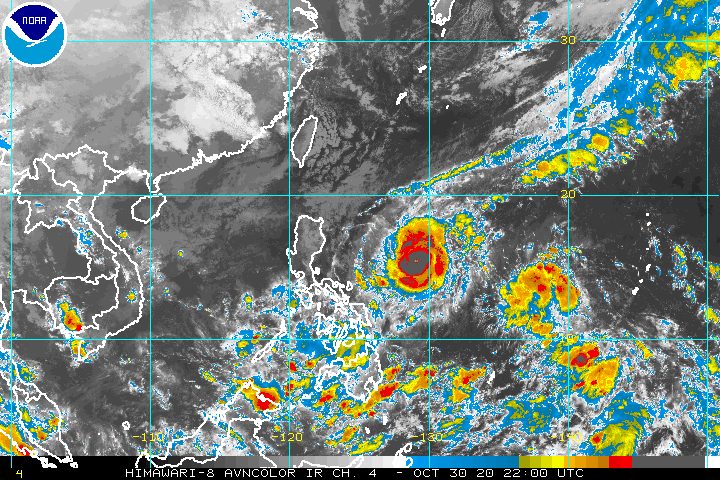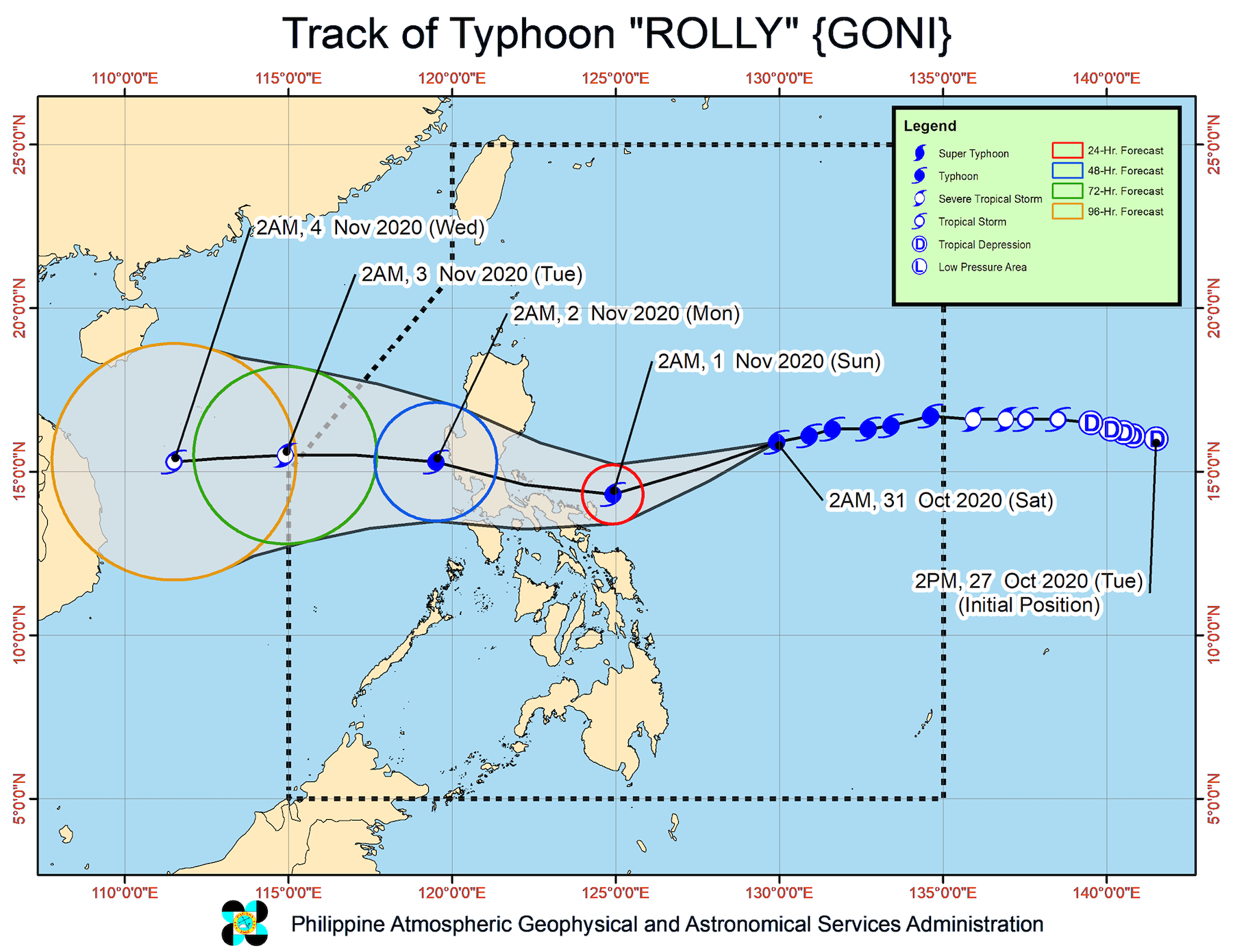SUMMARY
This is AI generated summarization, which may have errors. For context, always refer to the full article.

Signal No. 2 was raised due to Typhoon Rolly (Goni) for the first time before dawn on Saturday, October 31, as it moved closer to the region of Bicol.
The Philippine Atmospheric, Geophysical, and Astronomical Services Administration (PAGASA) said in a bulletin released past 5 am on Saturday that Rolly is now 655 kilometers east northeast of Virac, Catanduanes.
The typhoon is moving west at a slightly faster 20 kilometers per hour (km/h) from the previous 15 km/h.
PAGASA said Rolly will head for the sea off the coast of Bicol on Saturday, going near the region.
Then beginning early Sunday morning, November 1, “it will gradually turn towards the west northwest, bringing its inner rainbands-eyewall region near or over” Catanduanes, Camarines Norte, and Camarines Sur in the morning and afternoon, and over the Quezon-Aurora area in the evening.
“The center of the eye of the typhoon is forecast to pass very close or over the Calaguas Islands” in Camarines Norte on Sunday afternoon.
On Sunday evening, it could make landfall in Quezon province’s Polillo Island and in mainland Quezon, said PAGASA, narrowing down potential landfall areas for the typhoon.
Following its landfall, Rolly will cross Central Luzon, then exit mainland Luzon landmass on Monday morning, November 2.
Rolly continues to have maximum sustained winds of 215 km/h and gustiness of up to 265 km/h. If its maximum sustained winds exceed 220 km/h, it would be classified as a super typhoon. (READ: FAST FACTS: Tropical cyclones, rainfall advisories)
PAGASA said there remains a possibility that Rolly will reach super typhoon category in the next 12 hours. But it said that Rolly “is more likely to be near super typhoon strength (185 to 215 km/h)” by the time it grazes Bicol and makes landfall over Quezon.
While crossing Central Luzon, the typhoon “is forecast to weaken considerably and emerge as a severe tropical storm or minimal typhoon over the West Philippine Sea.”
But for now, Rolly remains a powerful typhoon heading toward land.
Below are the areas under tropical cyclone wind signals as of 5 am on Saturday. Parts of Bicol are under Signal No. 2, while considerably more areas were added to Signal No. 1, including Metro Manila and Calabarzon.
Signal No. 2
- Catanduanes
- eastern part of Camarines Sur (Caramoan, Garchitorena, Lagonoy, Tinambac, Siruma, Presentacion, San Jose, Goa, Buhi, Sagñay, Tigaon, Ocampo, Iriga City, Baao, Nabua, Bato, Balatan, Bula, Pili, Calabanga, Naga City, Bombon, Magarao, Canaman, Gainza, Milaor, Camaligan, Minalabac)
- Albay
- Sorsogon
Signal No. 1
- Camarines Norte
- rest of Camarines Sur
- Masbate including Ticao and Burias Islands
- Quezon including Polillo Island
- Rizal
- Laguna
- Cavite
- Batangas
- Marinduque
- Romblon
- Occidental Mindoro including Lubang Island
- Oriental Mindoro
- Metro Manila
- Bulacan
- Pampanga
- Bataan
- Zambales
- Tarlac
- Nueva Ecija
- Aurora
- Pangasinan
- Benguet
- Ifugao
- Nueva Vizcaya
- Quirino
- southern part of Isabela (Aurora, Luna, Reina Mercedes, Naguilian, Benito Soliven, San Mariano, Palanan, Dinapigue, San Guillermo, Echague, San Agustin, Jones, Cordon, Santiago City, Ramon, San Isidro, Angadanan, Alicia, Cauayan City, Cabatuan, San Mateo)
- Northern Samar
- northern part of Samar (Tagapul-an, Almagro, Santo Niño, Tarangnan, Catbalogan City, Calbayog City, Santa Margarita, Gandara, Pagsanghan, San Jorge, Jiabong, Motiong, Paranas, San Jose de Buan, Matuguinao)
- northern part of Eastern Samar (Taft, Can-avid, Dolores, Maslog, Jipapad, Arteche, Oras, San Policarpo)
- northern part of Biliran (Kawayan, Maripipi)
PAGASA warned areas under Signal No. 2 to brace for damaging gale-force to storm-force winds in the next 24 hours, while areas under Signal No. 1 will experience strong breeze to near gale conditions.
Signal No. 4 remains the highest possible tropical cyclone wind signal that may be raised, for very destructive typhoon-force winds.
“Elsewhere, strong breeze to near gale conditions due to the northeasterlies will be experienced over Batanes, Babuyan Islands, Ilocos Norte, Apayao, and the coastal and mountainous areas of Cagayan and Isabela that are not under [Signal No. 1],” added PAGASA.
The state weather bureau also updated its rainfall forecast for Rolly.
Light to moderate rain, with at times heavy rain (Rolly’s trough or extension)
Saturday morning to evening, October 31
- Central Visayas
- Negros Occidental
- Leyte
- Southern Leyte
- Palawan including Cuyo Islands
- Zamboanga Peninsula
- Northern Mindanao
- Caraga
- Sulu
Heavy to intense rain (Rolly)
Late Saturday evening, October 31, until Sunday, November 1
- Bicol
- Calabarzon
- Metro Manila
- Central Luzon
- Marinduque
- northern parts of Occidental Mindoro and Oriental Mindoro
Moderate to heavy rain (Rolly)
Late Saturday evening, October 31, until Sunday, November 1
- Cagayan
- Isabela
- Nueva Vizcaya
- Quirino
The rain could trigger floods, landslides, and “sediment-laden streamflows” such as lahar.
There is also a “moderate to high risk” of storm surges in the next 48 hours “which may result in life-threatening and damaging coastal inundation,” warned PAGASA.
- northern coastal areas of Quezon including Polillo Island – up to 3 meters high
- coastal areas of Aurora, Marinduque, Bicol, Northern Samar, and the other coastal areas of Quezon – up to 2 meters high
Storm surges could be “accompanied by swells and breaking waves reaching the coast.”
The state weather bureau warned as well that travel is risky for all types of vessels in:
- seaboards of areas under Signal Nos. 1 and 2 – rough to phenomenal seas, with waves 2.5 to 15 meters high
- remaining seaboards of Northern Luzon as well as eastern seaboards of Eastern Visayas that are not under a tropical cyclone wind signal and Caraga – rough to very rough seas, with waves 2.5 to 5 meters high
In the remaining seaboards of the country, there are moderate to rough seas, with waves 1.2 to 2.5 meters high. PAGASA advised those using small vessels to take precautionary measures, while “inexperienced mariners should avoid navigating in these conditions.”
Rolly could leave the Philippine Area of Responsibility (PAR) on Monday evening or in the early hours of Tuesday, November 3.

Meanwhile, Tropical Depression Atsani is still outside PAR, at 1,605 kilometers east of the Visayas.
The tropical depression is moving west northwest at the same speed of 25 km/h, and at this rate, may enter PAR on Sunday afternoon.
Once Atsani enters, it will be given the local name Siony. (READ: LIST: PAGASA’s names for tropical cyclones in 2020)
This means there would be two tropical cyclones inside PAR at the same time, though PAGASA said Atsani “remains less likely to affect any portion of the country” in the next 3 days.
Atsani continues to have maximum sustained winds of 55 km/h and gustiness of up to 70 km/h as of early Saturday. But it is likely to reintensify into a tropical storm in the next 24 to 48 hours.
Rolly is the Philippines’ 18th tropical cyclone for 2020, while Siony would be the 19th. Rolly is also the 5th tropical cyclone for October alone.
An average of 20 tropical cyclones form within or enter PAR each year.
These are PAGASA’s latest estimates for the number of tropical cyclones inside PAR in the next 6 months:
- November 2020 – 1 to 3
- December 2020 – 2 or 3
- January 2021 – 0 or 1
- February 2021 – 0 or 1
- March 2021 – 0 or 1
- April 2021 – 0 or 1
Last October 2, the state weather bureau warned Filipinos to expect more rain in the coming months due to the onset of La Niña. – Rappler.com
Add a comment
How does this make you feel?




There are no comments yet. Add your comment to start the conversation.